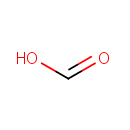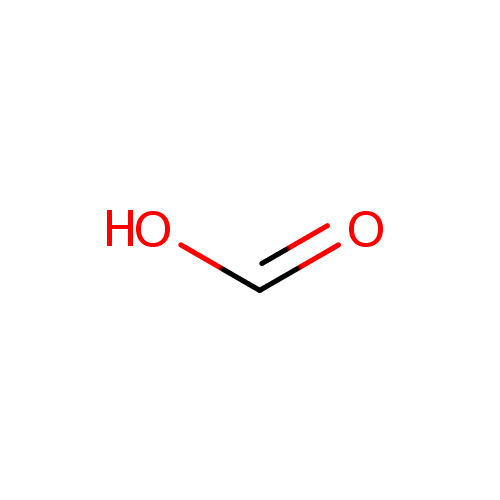
Formic acid (PAMDB000053)
| Record Information | |||||||||||||||||||||||||||||||||||||||||||||||||||||||||||||||||||||
|---|---|---|---|---|---|---|---|---|---|---|---|---|---|---|---|---|---|---|---|---|---|---|---|---|---|---|---|---|---|---|---|---|---|---|---|---|---|---|---|---|---|---|---|---|---|---|---|---|---|---|---|---|---|---|---|---|---|---|---|---|---|---|---|---|---|---|---|---|---|
| Version | 1.0 | ||||||||||||||||||||||||||||||||||||||||||||||||||||||||||||||||||||
| Update Date | 1/22/2018 11:54:54 AM | ||||||||||||||||||||||||||||||||||||||||||||||||||||||||||||||||||||
| Metabolite ID | PAMDB000053 | ||||||||||||||||||||||||||||||||||||||||||||||||||||||||||||||||||||
| Identification | |||||||||||||||||||||||||||||||||||||||||||||||||||||||||||||||||||||
| Name: | Formic acid | ||||||||||||||||||||||||||||||||||||||||||||||||||||||||||||||||||||
| Description: | Formic acid is the simplest carboxylic acid. Formate is an intermediate in normal metabolism. It takes part in the metabolism of one-carbon compounds and its carbon may appear in methyl groups undergoing transmethylation. It is eventually oxidized to carbon dioxide. In nature, formic acid is found in the stings and bites of many insects of the order Hymenoptera, including bees and ants. The principal use of formic acid is as a preservative and antibacterial agent in livestock feed. When sprayed on fresh hay or other silage, it arrests certain decay processes and causes the feed to retain its nutritive value longer. | ||||||||||||||||||||||||||||||||||||||||||||||||||||||||||||||||||||
| Structure | |||||||||||||||||||||||||||||||||||||||||||||||||||||||||||||||||||||
| Synonyms: |
| ||||||||||||||||||||||||||||||||||||||||||||||||||||||||||||||||||||
| Chemical Formula: | CH2O2 | ||||||||||||||||||||||||||||||||||||||||||||||||||||||||||||||||||||
| Average Molecular Weight: | 46.0254 | ||||||||||||||||||||||||||||||||||||||||||||||||||||||||||||||||||||
| Monoisotopic Molecular Weight: | 46.005479308 | ||||||||||||||||||||||||||||||||||||||||||||||||||||||||||||||||||||
| InChI Key: | BDAGIHXWWSANSR-UHFFFAOYSA-N | ||||||||||||||||||||||||||||||||||||||||||||||||||||||||||||||||||||
| InChI: | InChI=1S/CH2O2/c2-1-3/h1H,(H,2,3) | ||||||||||||||||||||||||||||||||||||||||||||||||||||||||||||||||||||
| CAS number: | 64-18-6 | ||||||||||||||||||||||||||||||||||||||||||||||||||||||||||||||||||||
| IUPAC Name: | formic acid | ||||||||||||||||||||||||||||||||||||||||||||||||||||||||||||||||||||
| Traditional IUPAC Name: | formic acid | ||||||||||||||||||||||||||||||||||||||||||||||||||||||||||||||||||||
| SMILES: | OC=O | ||||||||||||||||||||||||||||||||||||||||||||||||||||||||||||||||||||
| Chemical Taxonomy | |||||||||||||||||||||||||||||||||||||||||||||||||||||||||||||||||||||
| Taxonomy Description | This compound belongs to the class of organic compounds known as carboxylic acids. These are compounds containing a carboxylic acid group with the formula -C(=O)OH. | ||||||||||||||||||||||||||||||||||||||||||||||||||||||||||||||||||||
| Kingdom | Organic compounds | ||||||||||||||||||||||||||||||||||||||||||||||||||||||||||||||||||||
| Super Class | Organic acids and derivatives | ||||||||||||||||||||||||||||||||||||||||||||||||||||||||||||||||||||
| Class | Carboxylic acids and derivatives | ||||||||||||||||||||||||||||||||||||||||||||||||||||||||||||||||||||
| Sub Class | Carboxylic acids | ||||||||||||||||||||||||||||||||||||||||||||||||||||||||||||||||||||
| Direct Parent | Carboxylic acids | ||||||||||||||||||||||||||||||||||||||||||||||||||||||||||||||||||||
| Alternative Parents | |||||||||||||||||||||||||||||||||||||||||||||||||||||||||||||||||||||
| Substituents |
| ||||||||||||||||||||||||||||||||||||||||||||||||||||||||||||||||||||
| Molecular Framework | Aliphatic acyclic compounds | ||||||||||||||||||||||||||||||||||||||||||||||||||||||||||||||||||||
| External Descriptors |
| ||||||||||||||||||||||||||||||||||||||||||||||||||||||||||||||||||||
| Physical Properties | |||||||||||||||||||||||||||||||||||||||||||||||||||||||||||||||||||||
| State: | Liquid | ||||||||||||||||||||||||||||||||||||||||||||||||||||||||||||||||||||
| Charge: | -1 | ||||||||||||||||||||||||||||||||||||||||||||||||||||||||||||||||||||
| Melting point: | 8.4 °C | ||||||||||||||||||||||||||||||||||||||||||||||||||||||||||||||||||||
| Experimental Properties: |
| ||||||||||||||||||||||||||||||||||||||||||||||||||||||||||||||||||||
| Predicted Properties |
| ||||||||||||||||||||||||||||||||||||||||||||||||||||||||||||||||||||
| Biological Properties | |||||||||||||||||||||||||||||||||||||||||||||||||||||||||||||||||||||
| Cellular Locations: | Cytoplasm | ||||||||||||||||||||||||||||||||||||||||||||||||||||||||||||||||||||
| Reactions: | 2-Ketobutyric acid + Coenzyme A > Formic acid + Propionyl-CoA Coenzyme A + Pyruvic acid <> Acetyl-CoA + Formic acid 2 Hydrogen ion + Menaquinone 8 + Formic acid > Menaquinol 8 + Carbon dioxide + Hydrogen ion 2 Hydrogen ion + Ubiquinone-8 + Formic acid > Ubiquinol-8 + Carbon dioxide + Hydrogen ion Formic acid + Hydrogen ion > Carbon dioxide + Hydrogen (gas) S-Formylglutathione + Water <> Formic acid + Glutathione + Hydrogen ion N10-Formyl-THF + Water <> Formic acid + Hydrogen ion + Tetrahydrofolic acid Guanosine triphosphate + 3 Water <> 2,5-Diamino-6-hydroxy-4-(5-phosphoribosylamino)pyrimidine + Formic acid +2 Hydrogen ion + Pyrophosphate + 2,5-diamino-6-hydroxy-4-(5-phospho-D-ribosylamino)pyrimidine Adenosine triphosphate + Formic acid + Glycineamideribotide > ADP + 5'-Phosphoribosyl-N-formylglycineamide + Hydrogen ion + Phosphate Guanosine triphosphate + Water > Dihydroneopterin triphosphate + Formic acid + Hydrogen ion Water + Undecaprenyl phosphate-4-amino-4-formyl-L-arabinose > Formic acid + undecaprenyl phosphate-4-amino-4-deoxy-L-arabinose Formyl-CoA + Oxalic acid <> Formic acid + Oxalyl-CoA D-Ribulose 5-phosphate <> 3,4-Dihydroxy-2-butanone-4-P + Formic acid + Hydrogen ion 5-Aminoimidazole ribonucleotide + Water + NAD > 4-Amino-2-methyl-5-phosphomethylpyrimidine +2 Formic acid +3 Hydrogen ion + NADH Guanosine triphosphate + 3 Water <> Formic acid + 2,5-Diamino-6-hydroxy-4-(5-phosphoribosylamino)pyrimidine + Pyrophosphate Formic acid + NAD <> Hydrogen ion + Carbon dioxide + NADH S-Formylglutathione + Water <> Formic acid + Glutathione N10-Formyl-THF + Water <> Formic acid + Tetrahydrofolic acid 4-Amino-5-hydroxymethyl-2-methylpyrimidine + S-Adenosylmethionine <> 5-Aminoimidazole ribonucleotide + 4-Amino-2-methyl-5-phosphomethylpyrimidine + 5'-Deoxyadenosine + L-Methionine + Formic acid + CO Formamidopyrimidine nucleoside triphosphate + Water <> 2,5-Diaminopyrimidine nucleoside triphosphate + Formic acid D-Ribulose 5-phosphate <> 3,4-Dihydroxy-2-butanone-4-P + Formic acid 4-deoxy-4-formamido-α-L-arabinopyranosyl <i>ditrans,octacis</i>-undecaprenyl phosphate + Water > 4-amino-4-deoxy-α-L-arabinopyranosyl <i>ditrans,octacis</i>-undecaprenyl phosphate + Formic acid Water + formyl-L-methionyl peptide > Hydrogen ion + methionyl peptide + Formic acid More...Formic acid + Hydrogen ion + a menaquinone > Hydrogen ion + Carbon dioxide + a menaquinol Adenosine triphosphate + Formic acid + Tetrahydrofolic acid > ADP + Phosphate + N10-Formyl-THF Water + Guanosine triphosphate > Hydrogen ion + Pyrophosphate + 2,5-Diamino-6-hydroxy-4-(5-phosphoribosylamino)pyrimidine + Formic acid 5-Aminoimidazole ribonucleotide + S-Adenosylmethionine 4-Amino-2-methyl-5-phosphomethylpyrimidine + 5'-Deoxyadenosine + L-Methionine + Formic acid + carbon monoxide + Hydrogen ion Formic acid + an oxidized electron acceptor + Hydrogen ion > Carbon dioxide + a reduced electron acceptor 4-deoxy-4-formamido-beta-L-arabinose di-trans,poly-cis-undecaprenyl phosphate + Water > 4-amino-4-deoxy-alpha-L-arabinose di-trans,poly-cis-undecaprenyl phosphate + Formic acid Formyl-L-methionyl peptide + Water > Formic acid + methionyl peptide Formic acid + NAD > Carbon dioxide + NADH Formic acid + acceptor > Carbon dioxide + reduced acceptor Guanosine triphosphate + Water > Formic acid + 2-amino-4-hydroxy-6-(erythro-1,2,3-trihydroxypropyl)-dihydropteridine triphosphate Formic acid + Adenosine triphosphate + 5'-Phospho-ribosylglycinamide > 5'-Phosphoribosyl-N-formylglycineamide + ADP + Pyrophosphate D-Ribulose 5-phosphate > Formic acid + 1-Deoxy-L-glycero-tetrulose 4-phosphate Formic acid + Quinone <> Carbon dioxide + Hydroquinone Guanosine triphosphate + Water <> Formic acid + Dihydroneopterin triphosphate N1-(5-phospho-β-D-ribosyl)glycinamide + Adenosine triphosphate + Formic acid > 5'-Phosphoribosyl-N-formylglycinamide + Adenosine diphosphate + Phosphate + Hydrogen ion + 5'-Phosphoribosyl-N-formylglycineamide + ADP Formic acid + Tetrahydrofolic acid + Tetrahydrofolic acid > Water + 10-Formyltetrahydrofolate + N10-Formyl-THF Guanosine triphosphate + Water > Formic acid + Hydrogen ion + 7,8-dihydroneopterin 3'-triphosphate 2-Ketobutyric acid + Coenzyme A > Formic acid + Propionyl-CoA + Propionyl-CoA D-Ribulose 5-phosphate > 1-Deoxy-L-glycero-tetrulose 4-phosphate + Formic acid + Hydrogen ion Formic acid + menaquinone-8 + Electron + Hydrogen ion > Carbon dioxide + Hydrogen ion + Menaquinol 8 Guanosine triphosphate + 3 Water > Formic acid + Pyrophosphate +2 Hydrogen ion + 2,5-Diamino-6-(5'-phosphoribosylamino)-4-pyrimidineone | ||||||||||||||||||||||||||||||||||||||||||||||||||||||||||||||||||||
| Pathways: |
| ||||||||||||||||||||||||||||||||||||||||||||||||||||||||||||||||||||
| Spectra | |||||||||||||||||||||||||||||||||||||||||||||||||||||||||||||||||||||
| Spectra: |
| ||||||||||||||||||||||||||||||||||||||||||||||||||||||||||||||||||||
| References | |||||||||||||||||||||||||||||||||||||||||||||||||||||||||||||||||||||
| References: |
| ||||||||||||||||||||||||||||||||||||||||||||||||||||||||||||||||||||
| Synthesis Reference: | Finholt, Albert E.; Jacobson, Eugene C. The reduction of carbon dioxide to formic acid with lithium aluminum hydride. Journal of the American Chemical Society (1952), 74 3943-4. | ||||||||||||||||||||||||||||||||||||||||||||||||||||||||||||||||||||
| Material Safety Data Sheet (MSDS) | Download (PDF) | ||||||||||||||||||||||||||||||||||||||||||||||||||||||||||||||||||||
| Links | |||||||||||||||||||||||||||||||||||||||||||||||||||||||||||||||||||||
| External Links: |
| ||||||||||||||||||||||||||||||||||||||||||||||||||||||||||||||||||||
Enzymes
- General function:
- Involved in iron ion binding
- Specific function:
- Removes the formyl group from the N-terminal Met of newly synthesized proteins. Requires at least a dipeptide for an efficient rate of reaction. N-terminal L-methionine is a prerequisite for activity but the enzyme has broad specificity at other positions
- Gene Name:
- def
- Locus Tag:
- PA0019
- Molecular weight:
- 19.4 kDa
Reactions
| Formyl-L-methionyl peptide + H(2)O = formate + methionyl peptide. |
- General function:
- Involved in GTP cyclohydrolase II activity
- Specific function:
- Catalyzes the conversion of GTP to 2,5-diamino-6- ribosylamino-4(3H)-pyrimidinone 5'-phosphate (DARP), formate and pyrophosphate
- Gene Name:
- ribA
- Locus Tag:
- PA4047
- Molecular weight:
- 22.1 kDa
Reactions
| GTP + 3 H(2)O = formate + 2,5-diamino-6-hydroxy-4-(5-phospho-D-ribosylamino)pyrimidine + diphosphate. |
- General function:
- Involved in 3,4-dihydroxy-2-butanone-4-phosphate synthase activity
- Specific function:
- Catalyzes the conversion of D-ribulose 5-phosphate to formate and 3,4-dihydroxy-2-butanone 4-phosphate
- Gene Name:
- ribB
- Locus Tag:
- PA4054
- Molecular weight:
- 39.4 kDa
Reactions
| D-ribulose 5-phosphate = formate + L-3,4-dihydroxybutan-2-one 4-phosphate. |
- General function:
- Involved in electron carrier activity
- Specific function:
- Formate dehydrogenase allows Pseudomonas aeruginosa to use formate as major electron donor during anaerobic respiration, when nitrate is used as electron acceptor. The beta chain is an electron transfer unit containing 4 cysteine clusters involved in the formation of iron-sulfur centers. Electrons are transferred from the gamma chain to the molybdenum cofactor of the alpha subunit
- Gene Name:
- fdnH
- Locus Tag:
- PA4811
- Molecular weight:
- 33.8 kDa
- General function:
- Involved in respiratory electron transport chain
- Specific function:
- Formate dehydrogenase allows Pseudomonas aeruginosa to use formate as major electron donor during anaerobic respiration, when nitrate is used as electron acceptor. Subunit gamma is the cytochrome b556(FDN) component of the formate dehydrogenase
- Gene Name:
- fdnI
- Locus Tag:
- PA4810
- Molecular weight:
- 23.9 kDa
- General function:
- Involved in formate dehydrogenase (NAD+) activity
- Specific function:
- Formate dehydrogenase allows Pseudomonas aeruginosa to use formate as major electron donor during anaerobic respiration, when nitrate is used as electron acceptor. The alpha subunit forms the active site
- Gene Name:
- fdnG
- Locus Tag:
- PA4812
- Molecular weight:
- 104.7 kDa
Reactions
| Formate + NAD(+) = CO(2) + NADH. |
- General function:
- Involved in carboxylesterase activity
- Specific function:
- Serine hydrolase involved in the detoxification of formaldehyde. Hydrolyzes S-formylglutathione to glutathione and formate. Shows also esterase activity against alpha-naphthyl acetate, lactoylglutathione, palmitoyl-CoA and several pNP-esters of short chain fatty acids
- Gene Name:
- yeiG
- Locus Tag:
- PA3628
- Molecular weight:
- 31.2 kDa
Reactions
| S-formylglutathione + H(2)O = glutathione + formate. |
- General function:
- Involved in ATP binding
- Specific function:
- Catalyzes two reactions:the first one is the production of beta-formyl glycinamide ribonucleotide (GAR) from formate, ATP and beta GAR; the second, a side reaction, is the production of acetyl phosphate and ADP from acetate and ATP
- Gene Name:
- purT
- Locus Tag:
- PA3751
- Molecular weight:
- 42.3 kDa
Reactions
| Formate + ATP + 5'-phospho-ribosylglycinamide = 5'-phosphoribosyl-N-formylglycinamide + ADP + diphosphate. |
- General function:
- Involved in hydrolase activity, acting on carbon-nitrogen (but not peptide) bonds, in linear amides
- Specific function:
- Catalyzes the deformylation of 4-deoxy-4-formamido-L- arabinose-phosphoundecaprenol to 4-amino-4-deoxy-L-arabinose- phosphoundecaprenol. The modified arabinose is attached to lipid A and is required for resistance to polymyxin and cationic antimicrobial peptides (Probable)
- Gene Name:
- arnD
- Locus Tag:
- PA3555
- Molecular weight:
- 32.9 kDa
Reactions
| 4-deoxy-4-formamido-beta-L-arabinose di-trans,poly-cis-undecaprenyl phosphate + H(2)O = 4-amino-4-deoxy-alpha-L-arabinose di-trans,poly-cis-undecaprenyl phosphate + formate. |
- General function:
- Involved in thiamine biosynthetic process
- Specific function:
- Catalyzes the synthesis of the hydroxymethylpyrimidine phosphate (HMP-P) moiety of thiamine from aminoimidazole ribotide (AIR) in a radical S-adenosyl-L-methionine (SAM)-dependent reaction
- Gene Name:
- thiC
- Locus Tag:
- PA4973
- Molecular weight:
- 69.8 kDa
Reactions
| 5-amino-1-(5-phospho-D-ribosyl)imidazole + S-adenosyl-L-methionine = 4-amino-2-methyl-5-phosphomethylpyrimidine + 5'-deoxyadenosine + L-methionine + formate + CO. |

